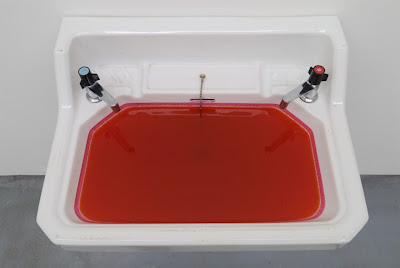Review Sabine B. Vogel, Vienna/Austria, ARTFORUM, New York 2005
| Jårg Geismar |
| Sabine B. Vogel: Jårg Geismar, Jiri Svestka Gallery. |
| In: Art Forum, April 2005, p. 199 |
The word "daydreaming" was written in yellow Letraset on the narrow glass-brick wall in the gallery's front room– turning this found architectural element into a cover page announcing the exhibition's title. The Swedish-German artist Jårg Geismar let himself be inspired by Prague, a fascinating city of contrasts, known for its "K and K" ("Kaiserlich und Königlich," that is, "imperial and royal") architecture from the Hapsburg era and as a hotspot of the European rave scene. Eschewing specific reference, the works–although for the most part created here–seemed more the product of an emotional than a topographical exploration of the city. The drawings, done directly on glass or on paper framed between glass, were reminiscent of associative sketches jotted down quickly in a café to capture a fleeting thought, a street scene, an architectural vista–but one we cannot exactly decipher. For the most part the drawings remain abstract. A clearer language is spoken by the objects Geismar has assembled, such as a dried bouquet of flowers held out in front of an open pair of scissors sticking horizontally from the wall (Nature morte, 2004) or the three cables running across the room attached to the walls with table knives (Dinner for Six, 2004).
The word "daydreaming" was written in yellow Letraset on the narrow glass-brick wall in the gallery's front room– turning this found architectural element into a cover page announcing the exhibition's title. The Swedish-German artist Jårg Geismar let himself be inspired by Prague, a fascinating city of contrasts, known for its "K and K" ("Kaiserlich und Königlich," that is, "imperial and royal") architecture from the Hapsburg era and as a hotspot of the European rave scene. Eschewing specific reference, the works–although for the most part created here–seemed more the product of an emotional than a topographical exploration of the city. The drawings, done directly on glass or on paper framed between glass, were reminiscent of associative sketches jotted down quickly in a café to capture a fleeting thought, a street scene, an architectural vista–but one we cannot exactly decipher. For the most part the drawings remain abstract. A clearer language is spoken by the objects Geismar has assembled, such as a dried bouquet of flowers held out in front of an open pair of scissors sticking horizontally from the wall (Nature morte, 2004) or the three cables running across the room attached to the walls with table knives (Dinner for Six, 2004).
Again and again, Geismar looks for ways to enter into international dialogue through his exhibitions. His show in Stockholm was called "The Optimists–A World of Unlimited Possibilities." The title "Daydreaming," as well, seems to be of a piece with this carefree, life-affirming outlook. But clearly there were some stark dissonances mixed in, for among the drawings was hung a bathroom sink filled with red ink and water, Suicide Room X, 2004, which interrupted our open-eyed dreaming with harsh reality. What first seemed like a lighthearted, atmospheric romp through a fascinating city ultimately conveyed an ambivalence lurking just behind the blurred references–a feeling that finds its perfect visual metaphor in the glass blocks Geismar turned into an artwork at the entrance.
Translated from German by Sara Ogger
Abonnieren
Kommentare (Atom)



























